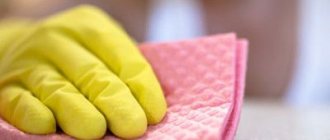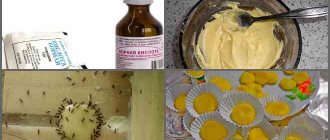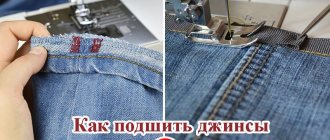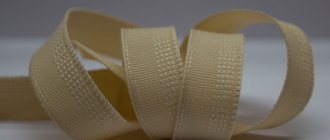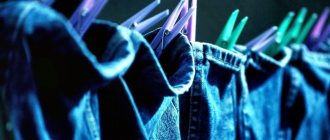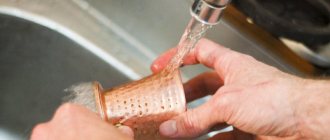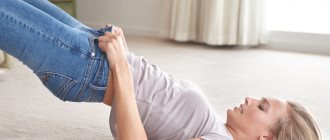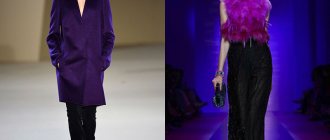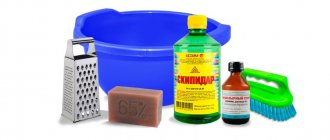Nowadays everything can be tucked up, with the exception of jeggings, skinnies and flares. Although the latter, even if they perfectly emphasize the figure, can also look stylish with a lapel, only on a man with very long legs it will look funny. But straight classic ones are the most versatile style, and boyfriend trousers, which have remained popular for more than one season, with cuffs on the pants will make you irresistible.
All that remains is to find out how to make cuffs on women's jeans so that it is stylish.
What is the secret of the popularity of women's trousers with cuffs?
It is believed that the main reason for the demand for collars is, first of all, the desire to demonstrate elite, branded trousers of famous brands. To really shine, the fashionista will have to forget about second-hand stores.
After all, you will need to demonstrate not only style, but also high-quality seam processing, which is not a shame to turn inside out. And trousers from the WESTLAND online store are perfect for this.
This fashion serves as a real imitation of the era of dudes, when the owner of such pants looks perky and flirtatious, at the same time festive. And don’t think that this idea comes from the provincials. Quite the contrary. Many fashion houses present total looks in their collections, teasing fashionistas and fashionistas all over the world.
Cuffs are stylish. They can look great on people of all different body types. Curvy shapes are visually corrected, shifting the emphasis from problem parts of the body to slender ankles.
Such items can be very easily combined with other items from your wardrobe.
Processing the waistband of children's knitted pants
Before sewing the belt to the top edge of the pants, you need to do a lot of preparatory work. And the first thing you need to do is to correctly measure the length (circumference) of the elastic band along the child’s waist. Do not tighten the waistband with an elastic band too much; the baby will be uncomfortable in such pants.
But, in any case, the elastic band should be smaller in volume than the strip of fabric cut for the belt.
Stitch the edges of the elastic together.
Connect the edges of the waistband with a straight stitch.
Now both of these parts need to be divided into four equal sections and marked with fabric pencil or chalk marks.
Steam press this seam.
Using a sleeve ironing block, fold the waistband fabric in half and iron it in the position shown in the photo.
Now you need to align the marks of the belt and elastic band and pin these areas with pins.
This is necessary in order to evenly distribute the elastic along the waistband.
In this form, the belt is ready to be sewn along the waist of the panties.
To prevent the elastic inside the waistband from twisting, and to make it more convenient for you to attach the waistband to your panties, sew four sections across the waistband, as shown in this photo.
To make the belt neat and beautiful, I advise you to do one more preparatory operation - secure the lower edge of the belt fabric with a straight stitch.
Sew along the bottom of the waistband so that the needle does not catch the elastic, but still be careful to stitch as close to the edge of the elastic as possible.
If the waistband allowance is too large, you can trim off the excess fabric with scissors.
Divide the waist circumference of the panties into four equal sections and connect the waistband, pinning the combined marks with pins.
Sew the waistband along the waistline of the pants, as shown in this photo.
While stitching, stretch the waistband slightly with both hands, keeping an eye on it. So that the needle does not move and passes into the hole in the needle plate. Otherwise, the needle may be bent or broken.
Finish the processing of the belt with an overlock or zigzag stitch.
This was the last operation of sewing children's pants with cuffs made of knitted fabric. Turn the waistband inside out and iron all areas of the panties.
How to make a one-piece belt with a wide elastic band for a children's skirt or pants.
Infinity cuff style
They are very similar to the familiar infinity symbol; this option is suitable for people who are used to constantly being in a bright and extraordinary image. Every fashionista wants to stand out from the gray mass, and therefore they use different methods. One of them was an experiment with an unusual type of cuff, which may resemble the famous infinity sign. This option applies to some types of jeans. To implement this sign on the cuffs, the jeans are turned up a few centimeters, and then half more. And after smoothing, you can get the desired result.
Editor's choice: What to wear with an elongated vest
Current shades
When choosing a product, you should definitely pay attention to its color scheme. Today, floral prints are very popular.
If you want to get a calmer and more neutral composition, you can give preference to the universal black color. These trousers look very elegant and at the same time are amazingly practical. They can be combined with any thing and always look great.
An excellent solution would be golden and ultramarine tones. Powder trousers are no less relevant. Today, blurry tones are very popular. An achromatic palette is also trending.
If you want to visually stretch your silhouette, you should pay attention to striped trouser models. In this case, the print should be of medium size. Too wide lines can have the opposite effect and make the figure appear more voluminous.
Other geometric prints are also very popular. Girls who are used to being the center of attention will suit elegant floral patterns or animalistic solutions.
If you want a neutral look, you can choose gingham trousers. To create a brighter and more expressive composition, you should pay attention to a large checkered pattern.
Lengthening sports pants
For the production of sportswear, elastic, knitted fabrics are usually used, so the best material for lengthening them is knitted elastic.
A cuff is cut out of it, which is sewn to the lower edge of the trouser leg. The cuff will be double, so its height is multiplied by 2 and a seaming allowance of 1.6 cm is added.
Sequencing:
- The cuffs are sewn down along the side seams, turned seam inside out and folded in half.
- Combine the inner seams of the trouser leg and cuff, baste the seam, stretching the elastic evenly.
- Once everything has gone well, the part is sewn on with an overlocker or zig-zag stitch, loosening the top thread.
Various finishing inserts made of contrasting, transparent or color-matching materials will help you lengthen your sweatpants.
The best option is if the fabrics match in stretchability, so that the stitching area looks neat. The inserts are placed under the knee, at knee level or at the bottom of the trouser leg.
Length Determination
Try on the pants. Decide where you want your pant leg to end and mark the spot with chalk. Using a ruler or centimeter, measure the distance by which you want to reduce them, write down this figure in centimeters. Good fitted pants should end about an inch above the floor. This length prevents you from tripping over your pant leg and also prevents situations where your jeans don't look right. Of course, the choice of length depends on personal preference.
What to wear with cuffed trousers
Every fashionista who always strives to be in trend is interested in what to wear with trousers with cuffs. In fact, there is nothing complicated; feel free to mix pants with any items in your wardrobe.
These trousers have a somewhat informal look, so you shouldn’t wear them with classic jackets, vests and shoes.
It's better to look for something unconventional so that the bows don't seem banal. A blazer or a sweatshirt are the things that go perfectly with trousers with cuffs. The look should be slightly casual and give the impression that you dressed in a hurry.
Remember that trousers are the brightest accent in the image, therefore, the top should be discreet and elegant. A turtleneck or long sleeve would be a good option. For a more dynamic look, intended, for example, for a party, choose a stylish blouse with asymmetrical elements or a jumper with a chaotic pattern.
A spectacular look in ethnic style can be created from an afghani, a T-shirt with an ethnic embossed pattern or embroidery, or a neckerchief with a floral print. Do not forget about the appropriate jewelry and accessories, without which it is difficult to imagine the image of an oriental beauty.
Pants with cuffs can be successfully used to create multi-layered looks. Pair your chinos with a denim shirt, leave it tucked into your pants, and layer it with a crewneck jumper on top. A fitted jacket and a voluminous scarf will add charm to a stylish look with a layered effect.
When composing a look with joggers, remember that it is better to move away from the sporty stylistic direction. Pants with a dropped crotch line fit perfectly into everyday style, and some fashionistas even wear them to work.
Combine them with tank tops, T-shirts, tunics and blouses and at least partially tuck the top into your trousers. In cool weather, wear a bomber jacket, biker jacket, smooth knit cardigan, or hoodie on top. You should not wear joggers with romantic blouses or a top embroidered with sequins. For an evening look, you can use a long sleeve made of leather and guipure or a bustier.
As for shoes, it all depends on the specific model. Joggers, chinos, bananas look great with moccasins, sneakers, slip-ons, sneakers, ballet flats. Afghanis and riding breeches are recommended to be worn with shoes with heels, and the lower the length of the trousers, the higher the heel should be. Dress pants require matching shoes. Shoes with a toe platform and pumps are suitable.
However, it all depends on your taste. Stylists encourage girls to experiment, because fashion today is democratic and lenient.
What is needed to create a pattern
The easiest way to sew sports trousers is to use a ready-made pattern for classic women's trousers. On the base pattern, connect the front and back halves of the trousers along the seam line and place on paper. Side seams are not needed here. Outline the inner step, middle and waist cuts, draw a line along the top, and ignore the darts - they are not needed for trousers with an elastic band. Outline the back sections, draw a straight line in the middle where you plan to stitch the stripes (this may be the position of the side sections earlier). Cut out the opposite side in a mirror image.
Processing the bottom of trousers with cuffs
A cuff is a decorative detail used to decorate the bottom of a trouser leg. Almost any type of trouser can have cuffs. They look great with jackets, sports jackets, blazers and cardigans. The only exceptions are tailcoats, business cards and tuxedos, i.e. items of evening wear.
In the previous publication, we looked at the technology of processing the bottom of trousers with a hem with an overcast cut and using trouser braid.
How to hem trousers: finishing the bottom of trousers with trouser braid
Most fashion historians agree that trouser cuffs owe their appearance to the British King Edward VII in the second half of the 19th century. He was the first to come up with the idea of tucking his trousers to protect them from dust and dirt.
It is not known exactly who and when first ordered trousers with cuffs from their tailor, however, men wearing such trousers began to appear in photographs from the beginning of the 20th century.
When choosing a trouser model with cuffs, keep in mind that:
- the front halves of the trousers are usually processed with tucks;
- the length of the trousers is cut shorter than usual, since the creases along the front arrow in trousers with cuffs look especially careless;
- The cuffs should be parallel to the floor, while adjacent to the back of the shoe, in no case protruding back.
Pants with cuffs are not suitable for short people, as they visually make the legs shorter. But if the desire to own them is irresistible, it is necessary to choose a narrower silhouette, and the length of the trousers should be even shorter to compensate for the effect of the cuffs. Sometimes cuffed pants are so short that they don't even touch the shoes. This clearly defines them as an informal wardrobe.
Men: spring/summer 2015
Men's fashion, casual style
Option 1. Processing the bottom of trousers with double cuffs
Step 1
Making allowance for processing double cuffs on men's straight trousers.
At the cutting stage, mark the hem line for the bottom at a distance from the top cut equal to the length of the finished trousers. From this line, set the width of the cuff down and draw a horizontal line. Then set aside the width of the cuff again and draw a third horizontal line.
Additionally, provide an allowance for processing the lower cut of 1.0 cm.
Bevel along the bottom line (see previous publication) is not performed.
Making allowance for processing double cuffs on men's tapered trousers.
It is performed in the same way as on straight trousers, but it is necessary to provide a bevel on the side and crotch seams so that the cuff gently fits the trouser leg, repeating its shape, and does not tighten it. To do this, additionally draw an auxiliary line (dotted line) above the hem line by the width of the cuff. Measure the width of the trouser leg at this level. Set aside exactly the same amount for the hem allowance, half on both sides of the arrow line. Connect these points with the side and step cuts along the hem line of the bottom. Perform this operation on both halves of the trousers.
Making an allowance for processing double cuffs on women's trousers.
The allowance for processing double cuffs is constructed in the same way as described above, with the exception of the width of the hem allowance. From the bottom line of the cuff, it is necessary to set down an allowance equal to the width of the cuff minus 1.0 cm, but not more than 4.0 cm.
Step 2
The bottom of classic men's trousers is processed using trouser braid. The trouser braid has a thickening on one edge, which protects the bottom of the trousers from abrasion.
Important!
Before use, the trouser braid must be decated: soaked in hot water, dried, ironed dry without stretching to avoid deformation.
Secrets of the WTO: what does it mean to iron?
The length of a piece of braid for processing one trouser leg is equal to twice the width of the trousers at the bottom plus 2 cm.
Mark the fold line of the cuff and the bottom line of the cuff on the front side of the trousers.
Place the trouser braid over the bottom allowance of the trousers so that its thickened edge lies on the cuff, overlapping the bottom line of the cuff by 0.1-0.2 cm, and the braid itself covers the raw edge of the hem. Baste the braid, starting from the crotch seam, with even tension. The bottom of the trousers should not be tightened, but the hem of the trousers should not be stretched out.
Step 3
Starting from the crotch seam, stitch the bottom edge of the trouser tape, stitching 0.2 cm from the thickened edge. Fold the free edge of the braid at the level of the crotch seam and perform a transverse tack.
Turn the bottom of the trousers to the wrong side, sweep the cuff along the fold line with straight running stitches. Sew the second edge of the trouser tape onto the trousers.
Step 4
Fold the cuff to the front side of the trousers, letting the thickened edge of the trouser tape extend beyond the hem line. Sweep it up.
Secure the edge of the cuff over the crotch and side seam by hand or by stitching exactly into the side and crotch seam. Iron.
How to properly wet-heat treat men's trousers
Note: In women's trousers, the double cuff is processed without trouser tape. The processing technology is shown below.
Step 1
Transfer the markings to the front side of the trousers using straight running stitches. Stitch the bottom edge.
Fold the cuff to the wrong side along the fold line of the cuff, sew with two lines: 1.0 cm from the fold of the cuff and 1.0 cm from the bottom edge.
Hem the hem allowance by hand using loose blind stitches.
Step 2
Turn the cuff to the front side of the trousers and sweep it up. Secure the edge of the cuff over the crotch and side seam by hand or by stitching exactly into the side and crotch seam. Iron.
Note: as a rule, trouser cuffs are made double, and only in cases where it is necessary to increase the length of trousers, one-and-a-half cuffs are processed.
Option 2. Processing the bottom of the trousers with one-and-a-half cuffs
When processing the bottom of trousers with one-and-a-half cuffs, the trousers are longer than with double cuffs, by half the width of the cuff.
Step 1
At the cutting stage, mark the hem line for the bottom at a distance from the top cut equal to the length of the finished trousers minus half the width of the cuff!
From this line down, set aside half the width of the cuff, draw a horizontal line - this is the top edge of the finished cuff.
Then set the width of the cuff down again and draw a third horizontal line - this is the bottom line of the finished trousers.
Additionally, provide allowance for processing the bottom. It is equal to half the width of the cuff + 1.0 cm.
Make a bevel along the side and step cuts if the silhouette of the trousers is tapered.
Transfer the markings to the front side of the trousers. Sew the bottom edge of the trousers.
Step 2
Place the trouser braid over the hem allowance of the trousers so that its thickened edge overlaps the hem line by 0.1-0.2 cm. Baste the braid, starting from the crotch seam, with uniform tension.
Stitch the bottom edge of the trouser tape, stitching 0.2 cm from the thickened edge. Fold the free edge of the braid at the level of the crotch seam and perform a transverse tack. Then, without interrupting the stitching, stitch the second side of the trouser tape 0.1-0.2 cm from the edge.
Step 3
Turn the seam allowance of the bottom of the trousers to the wrong side, align the overcast edge with the top marking line, overlapping it by 1.0 cm. Baste the edge of the allowance, stitch it onto the trousers along the marking line.
Step 4
Lay the cuff on two sides so that the seam line runs exactly in the middle, and the thickened edge of the braid extends to the bottom of the trousers as an even edge. Sweep and iron.
Secure the edge of the cuff over the crotch and side seam by hand or by stitching exactly into the side and crotch seam.
Option 3. Processing the bottom of the trousers with stitched double cuffs
If you don’t have enough fabric to cut out a full allowance for processing a double cuff, or you need to lengthen the trousers for an older child, you can use this method.
Step 1
Mark the bottom line at a distance from the top cut equal to the length of the finished trousers minus half the width of the cuff! Add a processing allowance of 1.0 cm.
Cut out the details of the cuffs in width equal to the details of the front and back halves. The height of the details of the hem cuffs is equal to 3.5 times the width of the finished cuffs. If the fabric of the trousers has a pronounced pattern, it will need to be adjusted when cutting the cuffs.
Mark horizontal lines on the cuff parts:
- from the top cut at a distance of 1.0 cm downwards;
- From the previous line downwards, set aside half the width of the cuff - this is the bottom line of the finished trousers;
- two lines at a distance of the width of the cuff - this is the bend line of the cuff and the second line of the bottom of the finished trousers;
- allowance for processing the bottom equal to the width of the cuff minus 1.0 cm (with a cuff width of at least 4 cm). The hem allowance should cover the seam allowances for the cuff stitching. If the cuff is already planned to be 4 cm, then the width of the allowance is equal to the width of the cuff.
Step 2
Transfer the line markings to the front side of the hem cuffs. Sew the front and back of the cuffs along the inseams and side seams into a ring. Press the seams. Stitch the bottom edge of the cuffs.
Baste the cuffs onto the bottom of the trousers with right sides facing each other, matching the side and crotch seams on the trousers and cuffs.
Sew the cuffs to the bottom of the trousers. Press seam allowances.
Step 3
Adjust the trouser tape to the allowance in the same way as when processing one-and-a-half cuffs.
Step 4
Turn the seam allowance of the bottom of the trousers to the wrong side. Baste the cuff 1.0 cm from the fold line of the cuff and 1.0 cm from the bottom edge. The overcast hem allowance should overlap the seam allowance for the cuff stitching.
Stitch the overcast edge of the trouser allowance or hand-hemm it with blind stitches.
Step 5
Turn the cuff to the front side of the trousers and sweep it up. Secure the edge of the cuff over the crotch and side seam by hand or by stitching exactly into the side and crotch seam. Iron.
Author of the master class and photo: Elena Lenkova
Lena has a higher and special education - a tailor of outerwear for men, women and children.
In clothing, she values individuality and thoughtfulness of the image, originality of cut. Likes to analyze modeling techniques and product processing technology. He runs his own page on Instagram. Many people know Lena as a long-time user of the BurdaStyle.ru website.
“The quality of workmanship and the internal finishing of a product are integral aspects of sewing.”
Material prepared by Yulia Dekanova
With trouser braid
Before hemming your pants, you need to decide on the color and texture of the braid. It can be purchased at textile stores.
Step by step steps:
- Make a fold line on the trousers;
- Attach trouser tape to it;
- Sew it exactly in a circle;
- The edge can be trimmed or finished with tape.
If the braid sticks out, it will quickly begin to shine and the pants will look sloppy. This method requires a high level of sewing. More suitable for hemming children's trousers.
Tapered models
Shorten pants without cutting
There are several ways that allow you to change the length of your pants without the intervention of scissors. Let's consider the main ones:
- Classic hand hemming. It is convenient because this option does not require special devices. All you need is a thread and a needle.
- On a sewing machine. This option differs significantly from the first in execution speed. For reliability, it is possible to use a double seam even on trousers with thick fabric.
- Using adhesive tape. This method can be used in cases where the length needs to be changed slightly and in a short time. Moreover, you can reduce the length to the original one.
How to roll up jeans to make them narrower?
Wide-leg jeans are incredibly comfortable, but often look baggy. To eliminate this shortcoming, the trousers can be made slightly tapered using a high-quality hem.
Designers offer several life hacks:
- A wide cuff (at least 5 centimeters) is fixed with an iron. It is important to make a small fold before folding.
- You can use an inside hem (especially if the jeans are too long). The principle of operation is the same, but only the formation, folds, and cuffs are performed on the inside of the trouser leg.
These methods of narrowing wide trousers are well suited for models made of thick fabrics, as well as insulated options.
If the jeans are made from light denim, then you can narrow them a little differently. To do this, first bend the trouser leg by 2-3 centimeters. Then form a fold and fold the cuff 2 more times.
There is also a universal technique in which the cuff is formed by rolling the pant leg in the hand with a roller. In this case, the jeans become 4 centimeters shorter, and the hem looks voluminous.
This model of children's pants can be worn without cuffs
The advantage of these children's pants made of knitted fabric is that their length is designed for growth. When the child grows up, you can simply unscrew the cuffs and the length of the trousers will increase by 7-8 cm.
Well, while the child has not yet grown up, you can turn the cuffs up and even secure them with threads.
Men's trouser sizes
How to measure pants correctly? Just remember two letters and their meanings: W and L
W – Waist circumference L – Pants leg length along the seam (inside, from the groin side)
Example: W34 L32
There is also a measurement based on hip circumference, but this is not a private parameter. You will see the letters W and L on the label all the time, but real professionals take into account the hip circumference during a careful and perfect fit to the figure.
Size chart for men's trousers (trousers)
| Waist(cm) | Hip circumference (cm) | RUSSIA | International standard | EUROPE | USA |
| 62-67 | 87-90 | 42 | XXS | 42 | 32 |
| 68-72 | 91-94 | 44 | XXS | 44 | 34 |
| 73-78 | 95-98 | 46 | XS | 46 | 36 |
| 79-84 | 99-102 | 48 | S | 48 | 38 |
| 85-90 | 103-106 | 50 | M | 50 | 40 |
| 91-96 | 107-110 | 52 | L | 52 | 42 |
| 97-102 | 109-113 | 54 | XL | 54 | 44 |
| 103-108 | 114-117 | 56 | XXL | 56 | 46 |
| 109-114 | 118-121 | 58 | XXXL | 58 | 48 |
| 115-119 | 122-125 | 60 | XXXL | 60 | 50 |
| 120-122 | 126-129 | 62 | XXXL | 62 | 52 |
| 123-125 | 130-132 | 64 | 4XL | 64 | 54 |
| 126-129 | 133-134 | 66 | 4XL | 66 | 56 |
| 130-134 | 135-137 | 68 | 5XL | 68 | 58 |
| 135-138 | 138-139 | 70 | 5XL | 70 | 60 |
- All data in the table are given for a man of average build (not overweight and not very thin)
- US sizes may be listed as 2.4, 6, 8, etc.
- European sizes may indicate the waist (W) and leg length (L) in inches, then multiply the value by 2.54 (1 inch = 2.54 cm) or use our table:
It's okay if the length of the trouser leg is longer than the length of your leg. The trousers can be easily trimmed in the workshop or folded with cuffs. In stores, labels immediately indicate height, for example, 182 or 188. For example, 52/172. Therefore, in length, be guided by the indicated height, and not by the length of the trouser leg. Anyway, you can only understand the length of the trousers by actually putting them on yourself.
This video will explain the correct length for dress pants. We advise you to view it.
What clothes and shoes to combine with?
Jeans with cuffs fit harmoniously into any style. For example, if you wear a formal shirt and jacket with them, you will get a stylish business look. For everyday walks, these jeans can be complemented with a turtleneck, sweater, loose shirt, top or cardigan.
But a lace top, blouse or tunic made of light fabrics will make the look sweet and romantic, which will be ideal for a date.
Well, lovers of grunge or punk style can wear cuffed jeans with a plaid shirt, a T-shirt with a themed print and a leather jacket or biker jacket.
It should be remembered that, thanks to such a pronounced decorative element at the bottom of the leg, jeans with cuffs visually shorten the legs a little. Therefore, for women of average or short stature, it is preferable to choose shoes with heels or wedges - sandals, pumps, clogs, ankle boots or platform sneakers - with such jeans. But tall ladies can afford ballet flats, sneakers, slips or other flat-soled shoes.
Jeans with cuffs look very stylish with white or colored sneakers, sneakers, oxfords, loafers and moccasins.
Preparing to shorten your trousers
This process requires little preparation. The height of the shortening is determined depending on the style of the pants. It is advisable to have an assistant at work: one puts on the trousers, and the other measures the length. You can take measurements from old trousers that have already been hemmed.
Model slacks
Step-by-step preparation for filing:
- Turn onto the inside of the trousers to be hemmed;
- Fold the product so that the seams touch;
- Mark the cut location on the outside;
- Make a straight line from the arrow;
- Draw a longitudinal line along both legs;
- Draw an allowance line for the bend, make a second parallel line a few cm lower than the first.
Note! Before starting the process, you can watch a simple video tutorial, after which the progress of the work will become clear.
What materials and tools to prepare
List of tools and materials for shortening pants:
- Fabric roller or scissors;
- Needles with needles;
- Textile marker, chalk or piece of soap;
- Iron;
- Centimeter.
It must be remembered that the threads are taken exactly to match the product so that they do not stand out against the general background.
How to add tags
The most traditional way to make marks is to use soap. Before you start cutting the pants, they need to be pinned together with needles so that the height of the bend does not fidget. It is recommended to do this with each pant leg in turn. Next, the pants will be hemmed in different ways, indicated below.
Women's trousers with arrows
How to make tapered trousers at home: basic rules
To alter trousers with a classic cut or flared model, you need to follow several rules that will help you achieve the perfect fit.
- Be sure to rip the crotch seams to remove creases.
- At the preparation stage, mark the knee line: this will help determine the exact position of the seams.
- For a successful fit and comfort when walking, do not forget to add 2-3 centimeters to the volume of the knee: for this you need to make preliminary measurements.
- The width of the bottom edge of the trousers should not exceed 15-18 centimeters.
- For bell-bottom trousers, draw the new leg size on the product that has not yet been cut: this will make it easier to trim off a large amount of excess fabric.
- In order to maintain symmetry, draw lines on one leg, then connect them to each other and then cut along the drawn outline.
How to attach a double cuff to trousers
If you were able to stitch the bottom edge of the tape on a sewing machine exactly 0.1-0.2 cm, then all you have to do is “pull” the cuff along its bottom edge and fix this position with a hot steam iron. The braid will “peek out” exactly 0.1-0.2 cm without attracting attention to itself and at the same time protect the fabric of the trousers from rubbing. If you were unable to carefully and evenly sew the bottom line on the tape, then you will have to lay out the cuff “by hand,” periodically checking how much the tape comes out from under the cuff and ironing this position.
To prevent the cuff on the trouser leg from turning back, it must be secured. This can be done in different ways, the main thing you need to know is that you don’t need to fasten it all over the circle, but only in two places. Namely, in both side seams of the trouser leg. The easiest way to secure the cuff is with a hand stitch, just make sure that the threads are not visible on the front side. You can stitch it on a sewing machine. And only exactly along the seam connecting the ladles of the trousers. Then the seam will be invisible and the cuff will be attached to the trousers more firmly. But this operation is quite complicated and requires skill, so it’s better to secure it with a regular hand stitch, and if the cuff comes off, it’s easy to sew it back on.
Marking the length of trousers and the width of the cuff
It is for this reason that trousers for school uniforms are often sold without finishing the bottom, and sometimes they even come with a trouser tape. In any case, if you have just such trousers, do not rush to take them to the studio and shorten them, try making a hem in the form of a double cuff with your own hands.
The most important thing is to make the markings correctly and not get confused on which side to sew the trouser tape on. But first, let's figure out how much fabric should be left to make a cuff. In the photo you see that on the conventional section of the trousers for the cuff you need to put two hems of 3.5 cm each and about 1 cm under the trouser tape, a total of 8 cm. But the fold can be made narrower, for example two 2.5 cm + 0.5 cm, that is, 5.5 cm.
Pay attention again to where the hem line for the bottom of the trousers is located, 8 cm or slightly less from the edge of the trouser leg.
Tags
have cuffs. trouser cuffs must cuffs must effect cuffs. double cuffs double cuffs the width of the cuff and double cuffs the width of the cuff. Trousers Trousers Trousers bottom of trousers bottom of trousers type of trousers can bottom of trousers in hem of hem of trouser trousers sewing of trousers in such trousers Stalin of trousers. The width of the trouser leg on one trouser leg is equal Processing of the bottom of the trousers processing of the bottom of the trouser shapes the bottom of the trousers. Processing of the bottom of the trousers processing of the bottom of the trousers Processing of the bottom of the trousers hem of the hem on the hem of the hem on the hem of the hem. Classic bottom
bottom lapel width stitched articles men's hidden hem men read narrow recommend
What you should pay attention to
First of all, the length of the jeans and your shoes. Once you have rolled up your jeans and made the cuff, the very bottom of your pant leg should be level with or just below the top of your boot. That is, when you stand straight, the cuff should end and the boot should begin immediately. Socks should not be visible, except when you are sitting or want to show off your crazy colored socks. Accordingly, when you wear brogues, the hem should be lower than when you wear high classic boots or Timberlands.
Dark blue jeans, double cuffed
Bare Stylish Socks - Double Cuff
Regular cuff
Rolled up jeans to match boot height
Funny socks can be revealed when you roll up your jeans
And one more thing about your height. The shorter the person, the narrower the cuffs should be made. The logic here is simple - narrow cuffs fit better with the proportions of a short man than wide ones.
